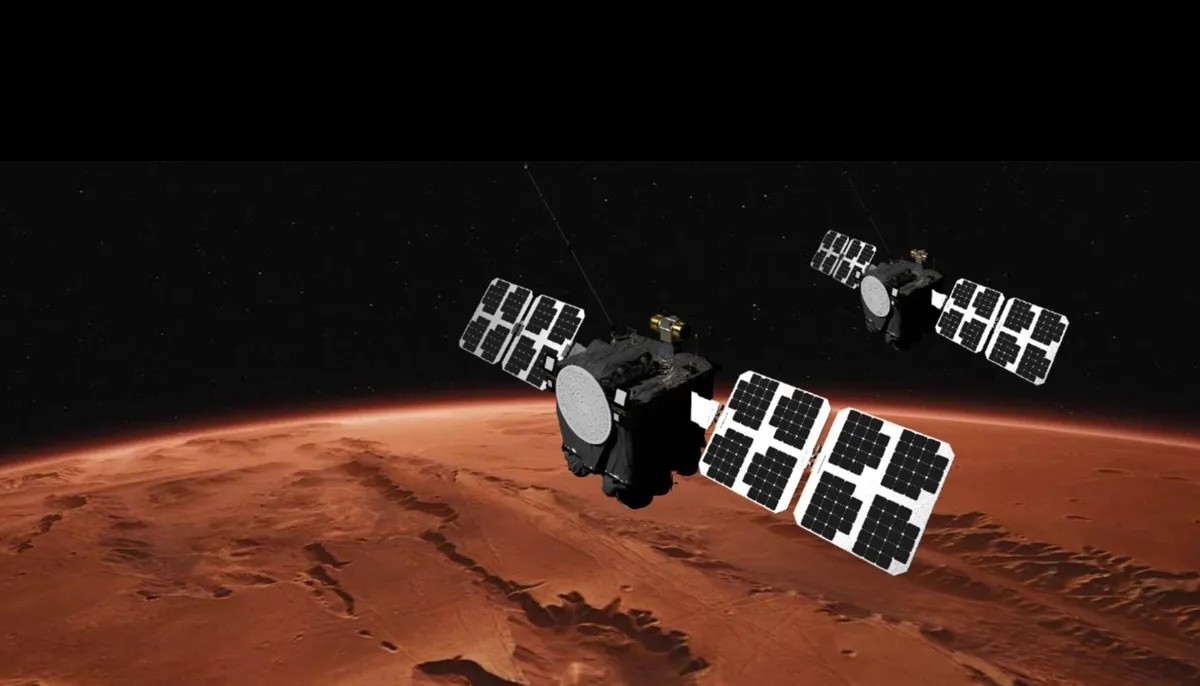15.11.2025
NASA, Blue Origin Launch Two Spacecraft to Study Mars, Solar Wind
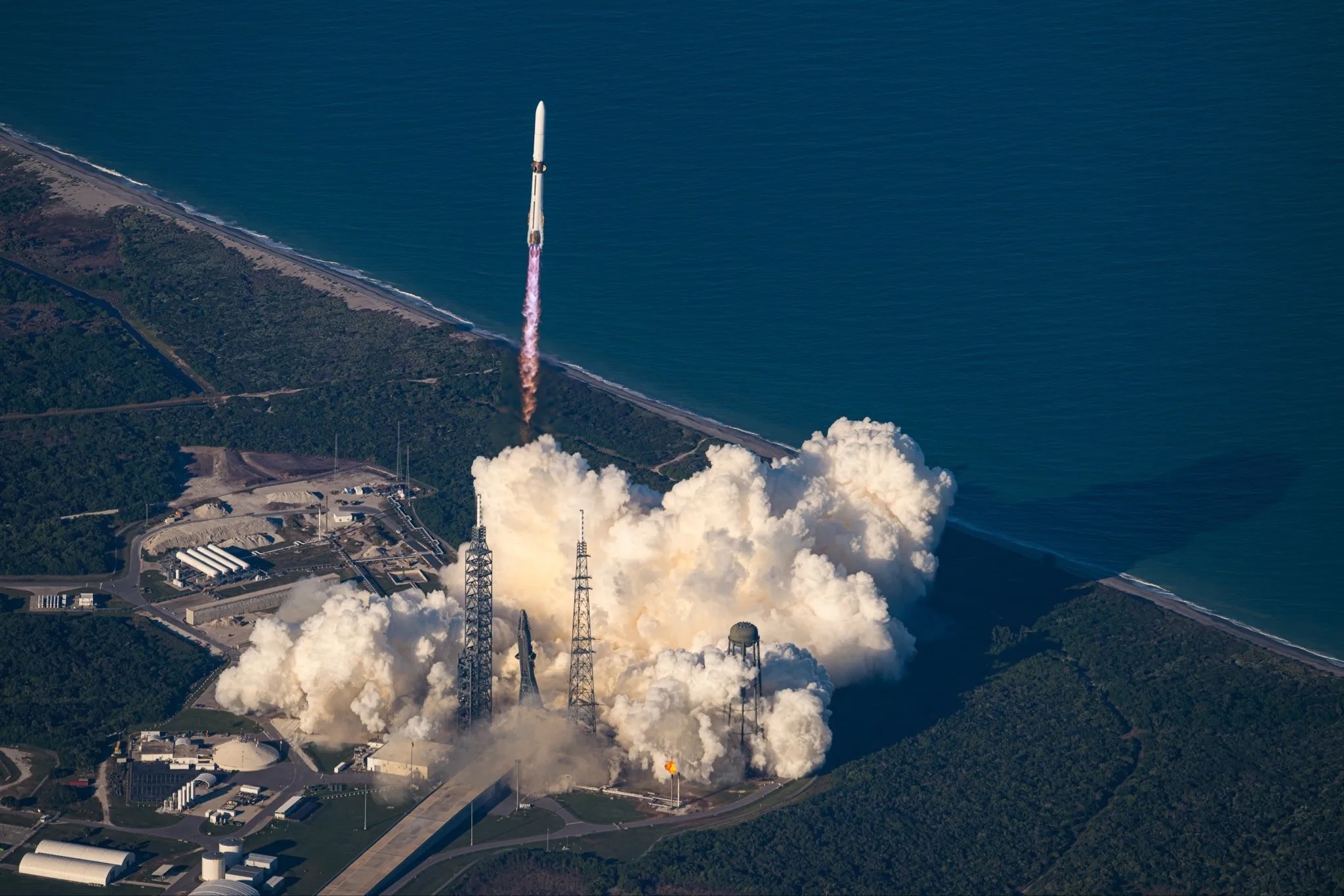
A pair of NASA spacecraft ultimately destined for Mars will study how its magnetic environment is impacted by the Sun. The mission also will help the agency prepare for future human exploration of Mars.
NASA’s ESCAPADE (Escape and Plasma Acceleration and Dynamics Explorers) spacecraft launched at 3:55 p.m. EST, Thursday, aboard a Blue Origin New Glenn rocket from Launch Complex 36 at Cape Canaveral Space Force Station in Florida.
“Congratulations to Blue Origin, Rocket Lab, UC Berkeley, and all our partners on the successful launch of ESCAPADE. This heliophysics mission will help reveal how Mars became a desert planet, and how solar eruptions affect the Martian surface,” said acting NASA Administrator Sean Duffy. “Every launch of New Glenn provides data that will be essential when we launch MK-1 through Artemis. All this information will be critical to protect future NASA explorers and invaluable as we evaluate how to deliver on President Trump’s vision of planting the Stars and Stripes on Mars.”
The twin spacecraft, built by Rocket Lab, will investigate how a never-ending, million-mile-per-hour stream of particles from the Sun, known as the solar wind, has gradually stripped away much of the Martian atmosphere, causing the planet to cool and its surface water to evaporate. The mission is led by the University of California, Berkeley.
Ground controllers for the ESCAPADE mission established communications with both spacecraft by 10:35 p.m. EST.
“The ESCAPADE mission is part of our strategy to understand Mars’ past and present so we can send the first astronauts there safely,” said Nicky Fox, associate administrator, Science Mission Directorate at NASA Headquarters in Washington. “Understanding Martian space weather is a top priority for future missions because it helps us protect systems, robots, and most importantly, humans, in extreme environments.”
New Glenn also carried a space communications technology demonstration from Viasat Inc., supporting NASA’s efforts to commercialize next-generation satellite relay services for science missions. Funded by the agency’s Communications Services Project, the demonstration transmitted launch telemetry data from the rocket’s second stage to an operations center on Earth through Viasat’s geostationary satellite network.
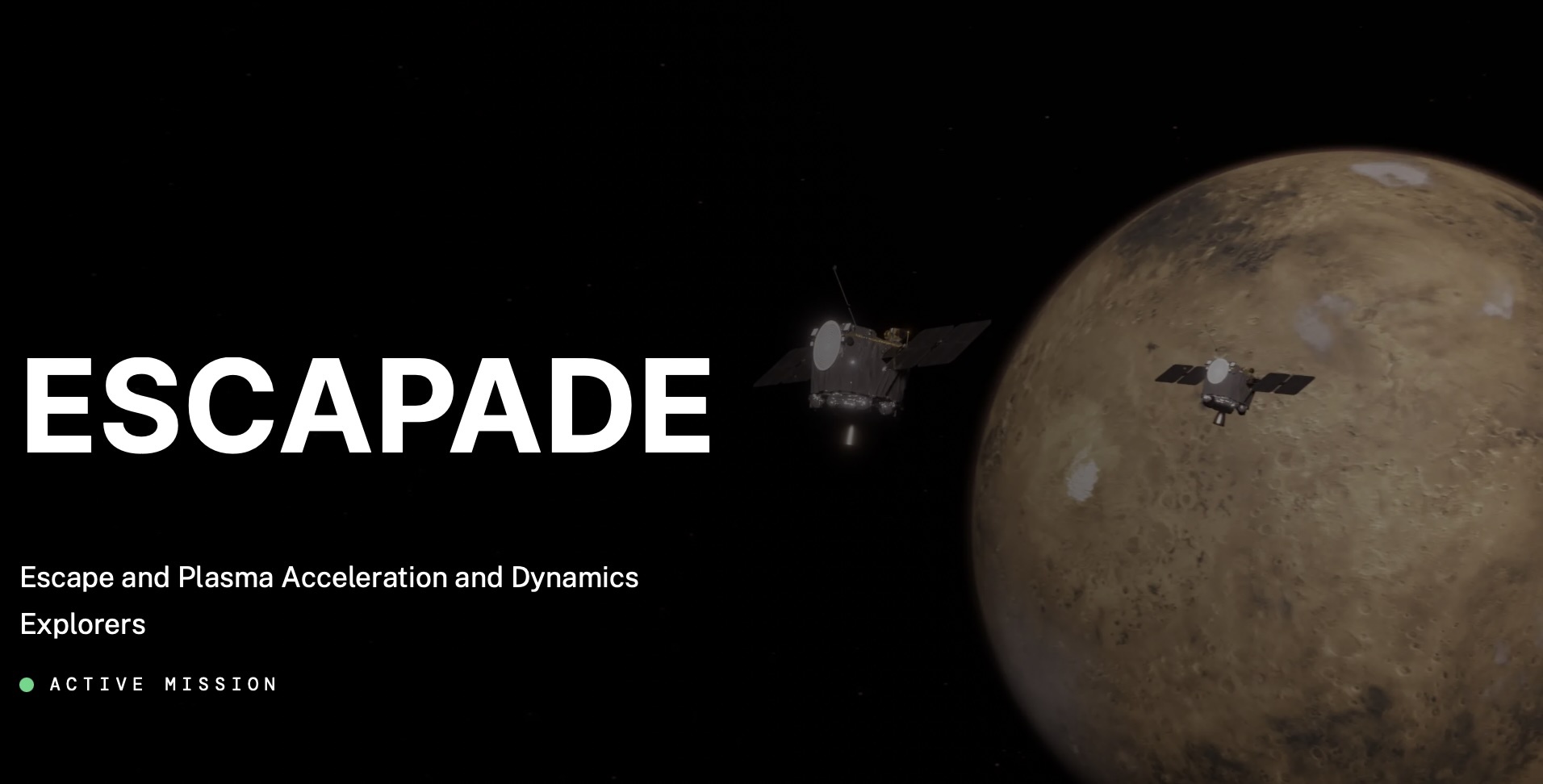
Blazing new trails
Recent solar activity, which triggered widespread auroras on Earth, caused a slight delay in launch to prevent solar storms from negatively impacting post-launch spacecraft commissioning. When ESCAPADE arrives at Mars, it will study present-day effects of the solar wind and solar storms on the Red Planet in real time. This will provide insights about Martian space weather and help NASA better understand the conditions astronauts will face when they reach Mars.
“The ESCAPADE spacecraft are now about to embark on a unique journey to Mars never traversed by any other mission,” said Alan Zide, ESCAPADE program executive at NASA Headquarters.
Rather than heading directly to Mars, the twin spacecraft will first head to a location in space a million miles from Earth called Lagrange point 2. Right now, Earth and Mars are on opposite sides of the Sun, which makes it harder to travel from one planet to the other. In November 2026, when Earth and Mars are closely aligned in their orbits, the ESCAPADE spacecraft will loop back to Earth and use Earth’s gravity to slingshot themselves toward Mars.
In the past, Mars missions have waited to launch during a brief window of time when Earth and Mars are aligned, which happens roughly every two years. However, with the type of trajectory ESCAPADE is using, future missions could launch nearly anytime and wait in space, queueing up for their interplanetary departure, until the two planets are in position.
This original “Earth-proximity” or “loiter” orbit also will make ESCAPADE the first mission to ever pass through a distant region of Earth’s magnetotail, part of our planet’s magnetic field that gets stretched out away from the Sun by the solar wind.
Studying Mars in stereo
After a 10-month cruise, ESCAPADE is expected to arrive at Mars in September 2027, becoming the first coordinated dual-spacecraft mission to enter orbit around another planet.
Over several months, the two spacecraft will arrange themselves in their initial science formation, in which the twin spacecraft will follow each other in the same “string-of-pearls” orbit, passing through the same areas in quick succession to investigate for the first time how space weather conditions vary on short timescales. This science campaign will begin in June 2028.
Six months later, both spacecraft will shift into different orbits, with one traveling farther from Mars and the other staying closer to it. Planned to last for five months, this second formation aims to study the solar wind and Mars’ upper atmosphere simultaneously, allowing scientists to investigate how the planet responds to the solar wind in real time.
In addition, ESCAPADE will provide more information about Mars’ ionosphere — a part of the upper atmosphere that future astronauts will rely on to send radio and navigation signals around the planet.
The ESCAPADE mission is funded by NASA’s Heliophysics Division and is part of NASA’s Small Innovative Missions for Planetary Exploration program. NASA’s Goddard Space Flight Center in Greenbelt, Maryland, Embry-Riddle Aeronautical University, and Advanced Space support the mission. NASA’s Launch Services Program, based at Kennedy Space Center in Florida, secured the launch service with Blue Origin under the Venture-class Acquisition of Dedicated and Rideshare contract.
Quelle: NASA
+++
New Glenn Launches NASA’s ESCAPADE, Lands Fully Reusable Booster
Cape Canaveral Space Force Station, Fla., (November 13, 2025)—The New Glenn orbital launch vehicle successfully completed its second mission, deploying NASA’s Escape and Plasma Acceleration and Dynamics Explorers (ESCAPADE) twin-spacecraft into the designated loiter orbit, and landing the fully reusable first stage on Jacklyn in the Atlantic Ocean.
New Glenn’s seven BE-4 engines ignited on Thursday, November 13, 2025, at 3:55:01 PM EST / 20:55:01 UTC from Launch Complex 36 at Cape Canaveral Space Force Station.
“We achieved full mission success today, and I am so proud of the team,” said Dave Limp, CEO, Blue Origin. “It turns out Never Tell Me The Odds had perfect odds—never before in history has a booster this large nailed the landing on the second try. This is just the beginning as we rapidly scale our flight cadence and continue delivering for our customers.”
The ESCAPADE spacecraft will begin their journey to Mars once the planets have returned to the ideal alignment in fall 2026. ESCAPADE will use two identical spacecraft to investigate how the solar wind interacts with Mars’ magnetic environment and how this interaction drives the planet’s atmospheric escape. In addition to deploying the NASA spacecraft, the Viasat HaloNet demonstration onboard New Glenn’s second stage successfully executed the first flight test of Viasat’s telemetry data relay service for NASA’s Communications Services Project.
“Congratulations to Blue Origin, Rocket Lab, UC Berkeley, and all of our partners on the successful launch of ESCAPADE," said the acting NASA Administrator, Secretary Sean Duffy. "This heliophysics mission will help reveal how Mars became a desert planet, and how solar eruptions affect the Martian surface. Every launch of New Glenn provides data that will be essential when we launch MK-1 through Artemis. All of this information will be critical to protect future NASA explorers and invaluable as we evaluate how to deliver on President Trump’s vision of planting the Stars and Stripes on Mars.”
New Glenn is foundational to advancing our customers’ critical missions and our own. The vehicle underpins our efforts to establish sustained human presence on the Moon, harness in-space resources, provide multi-mission, multi-orbit mobility through Blue Ring, and establish destinations in low Earth orbit.
The New Glenn program has several vehicles in production and multiple years of orders. In addition to NASA and Viasat, customers include Amazon’s Project Kuiper, AST SpaceMobile, and several telecommunications providers, among others. The mission marked the vehicle’s second National Security Space Launch (NSSL) certification flight. Blue Origin is certifying New Glenn with the U.S. Space Force for the NSSL program to meet emerging national security objectives.
"Today was a tremendous achievement for the New Glenn team, opening a new era for Blue Origin and the industry as we look to launch, land, repeat, again and again," said Jordan Charles, Vice President, New Glenn. "We've made significant progress on manufacturing at rate and building ahead of need. Our primary focus remains focused on increasing our cadence and working through our manifest."
Quelle: Blue Origin
+++
ROCKET LAB-BUILT TWIN SPACECRAFT BEGIN MARS JOURNEY FOR NASA AND UC BERKELEY’S ESCAPADE MISSION
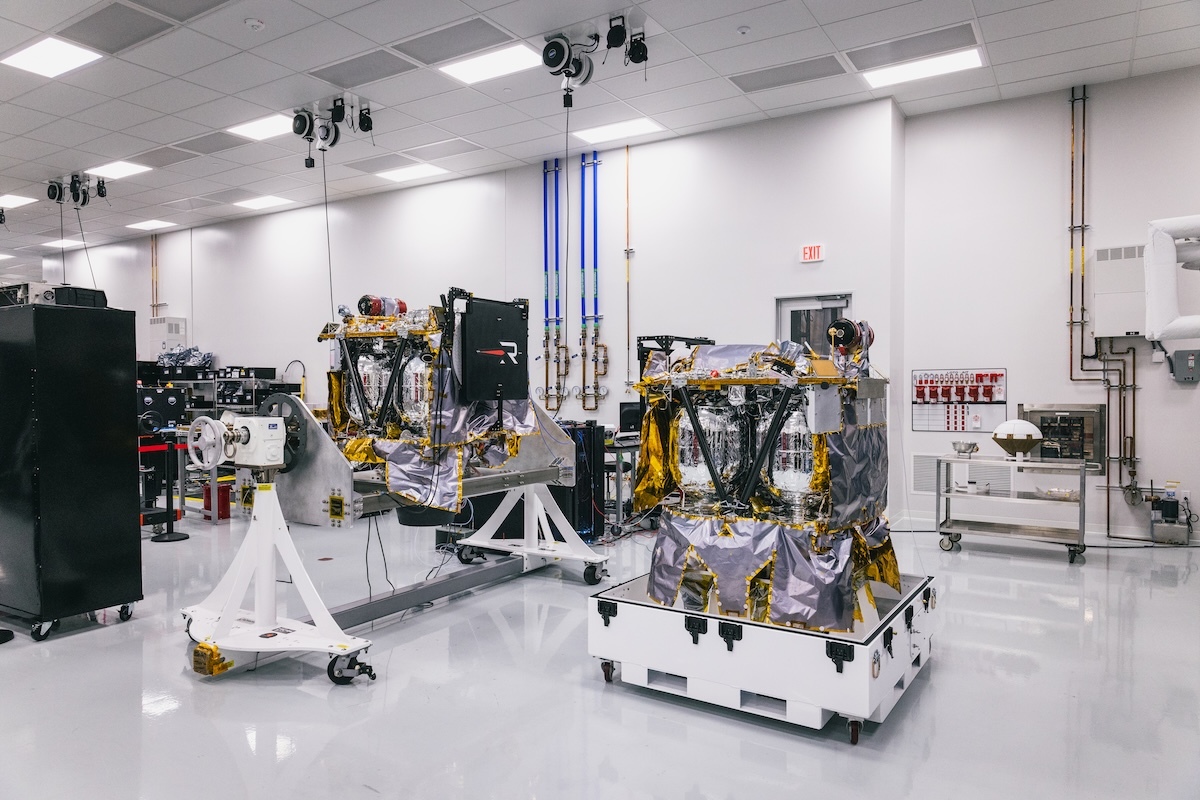
Twin satellites built by Rocket Lab for NASA and the University of California Berkeley’s Space Sciences Laboratory have been successfully launched on a mission to Mars, officially commencing the ESCAPADE science mission.
-
LONG BEACH, Calif., Nov. 13, 2025 (GLOBE NEWSWIRE) -- Rocket Lab Corporation (Nasdaq: RKLB) (“Rocket Lab” or “the Company”), a leading launch and space systems company, today announced its two Explorer-class spacecraft for NASA and the University of California Berkeley’s Space Sciences Laboratory have been successfully launched, beginning their journey to Mars to study the Red Planet’s magnetosphere. NASA’s Escape and Plasma Acceleration and Dynamics Explorers (ESCAPADE) mission was launched by Blue Origin on November 13, from Cape Canaveral Space Force Station at 03:55 p.m. EST.
Rocket Lab has successfully established contact with the spacecraft and they are generating power. Now in orbit, the spacecraft will undergo commissioning by Rocket Lab’s spacecraft operations team in the coming days, beginning with early checkouts including orientation stabilization and solar array deployment, followed by commissioning of flight computers, multiple antenna, guidance and navigation sensors and actuators, and the propulsion system leading up to the mission’s first maneuvers.
Rocket Lab’s Explorer-class spacecraft platform is a high delta-V, interplanetary member of its advanced satellite family. From contract award to launch, ESCAPADE moved from design to spacecraft completion in just three and a half years – an aggressive timeline for a Mars mission. This was made possible by the Company’s vertically integrated supply chain, which brings the production of solar arrays, reaction wheels, propellant tanks, star trackers, radios, avionics, flight software, and more entirely in-house.
“Mars missions have historically been measured in decades and come with price tags in the billions or hundreds of millions. With this mission we’re bringing Mars closer, proving real interplanetary science can be done faster and more cost-effectively to unlock the solar system,” said Sir Peter Beck, Founder and CEO of Rocket Lab. “ESCAPADE is a major first, not just for Rocket Lab, but for commercial interplanetary science. It’s the result of bold goals from NASA and UC Berkeley, enabled by our end-to-end spacecraft capabilities. We’re proud to play a part in this mission and even prouder to know they’re continuing our legacy at the Red Planet.”
Rob Lillis, ESCAPADE Principal Investigator and Associate Director for Planetary Science at the UC Berkeley Space Sciences Laboratory, says: "As PI, I'm very grateful to have a top-notch joint ops team at UC Berkeley and Rocket Lab taking care of the twin spacecraft out there in space. I'm both elated and relieved to see NASA’s ESCAPADE spacecraft healthy post-launch and looking forward to the next chapter of their journey to help us understand Mars' dynamic space weather environment."
Now in orbit, a complex and extended journey begins for Blue and Gold, with trajectory design led by Advanced Space LLC.
The alignment between Earth and Mars does not currently allow ESCAPADE to use a traditional direct-to-Mars transfer. Instead, ESCAPADE will launch into a “loiter” (or “Earth-proximity”) orbit that loops around Earth’s Lagrange point 2 (about a million miles from Earth, opposite the Sun) until the next planetary alignment window. Once the planets have reached the ideal alignment in fall 2026, the ESCAPADE spacecraft will use an Earth gravity assist to begin the journey to Mars.
Throughout the mission, Rocket Lab and UC Berkeley spacecraft operators will command the spacecraft to conduct deep-space maneuvers, known as trajectory correction maneuvers (TCMs). The TCMs will boost the spacecraft’s energy to reach Mars and provide navigation control to target their unique orbit insertion corridors. The spacecraft are scheduled to arrive at Mars in September 2027. The spacecraft will begin to transition to their first science formation in 2028.
ESCAPADE will allow scientists to understand how the solar wind strips ions from Mars’ atmosphere, offering insight into the planet’s atmospheric escape history and space weather environment, and informing future human exploration strategies.
Quelle: RocketLab
+++
NASA Mars ESCAPADE spacecraft (with kiwis) launch on New Glenn
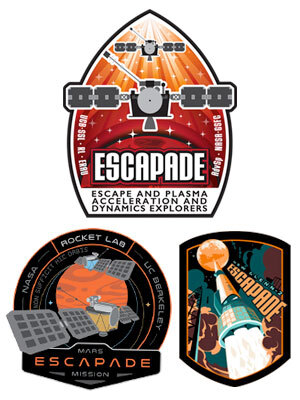
Three mission patches represent the Mars ESCAPADE mission and its partners. (NASA/Rocket Lab/Blue Origin)
November 13, 2025
— The first multi-spacecraft science mission to launch to Mars is now on its way and catching a ride on the twin probes are the first kiwis to fly to the Red Planet.
NASA's ESCAPADE (Escape and Plasma Acceleration and Dynamics Explorers) mission lifted off on a 22-month trip to Mars on Thursday (Nov. 13). Once there, the identical satellites will enter Martian orbit to study in real time how space weather affects the planet's hybrid magnetosphere and how the interaction drove Mars to lose its once dense atmosphere.
Led by the Space Sciences Laboratory at the University of California, Berkeley — the two spacecraft are named "Blue" and "Gold" after the school's colors — the ESCAPADE probes are the first Mars-bound vehicles to be designed, built and tested by Rocket Lab, the end-to-end space company headquartered in California but founded in New Zealand.
Hence, the kiwis.
"Rocket Lab has a tradition of hiding kiwis in many areas of its design," said Lindsay McLaurin, senior communications manager for space systems at Rocket Lab, in response to an inquiry from collectSPACE. "The birds have snuck onto our rockets and satellites since the beginning of the company, reflecting the New Zealand roots of the company and as a challenge among our designers and spacecraft builders."
The birds, which are native to the island country in the southwestern Pacific Ocean, appear as graphics on twin plaques attached to Blue and Gold. The metal plates, which adorn one of the two solar panels on each probe, also feature the Rocket Lab logo, the company's motto ("Non Sufficit Hic Orbis" or "This World Is Not Enough") and a similar icon of a bald eagle.
"To represent our company's global presence," said McLaurin, referring to the American icon.
From flightless to flight
Kiwis are flightless birds, hence their need to hitch a ride off of Earth. In this case, it was Blue Origin's New Glenn heavy-lift rocket.
ESCAPADE flew on the second New Glenn flight, NG-2. The vehicle left Launch Complex 36 at 3:55 p.m. EST (2055 GMT) on Thursday from the Cape Canaveral Space Force Station in Florida. The rocket's first stage, named "Never Tell Me the Odds," then returned to a landing on Blue Origin's recovery ship, "Jacklyn," a first for the company.
ESCAPADE Blue was deployed just over a half hour into the flight, followed by Gold about 30 seconds later. Both mini-fridge-size satellites entered a "loiter" orbit to loop around Lagrange point 2 (L-2), located about a million miles (1.6 million kilometers) away, opposite the Sun, until Earth and Mars again align in the fall of 2026. The spacecraft will then use a gravity assist to begin their 10-month transit to Mars.
Blue and Gold are expected to arrive at Mars in September 2027, separated by two days and then enter orbit at an initial altitude of 280 miles (450 kilometers). The spacecraft will then transition to a nearly identical science orbit, proceeding through a two-phase, multi-maneuver orbit reduction.
Between June 2028 and May 2029, Blue and Gold will carry out two science campaigns, first flying in formation in the same orbit and then in separate orbits. This approach of coordinated, multipoint observations will enable scientists to characterize the temporal variability and real-time response of Mars' near-space environment to space weather, or the flow of charged particles from solar wind. The data collected will help clarify the causes and effects, according to Robert Lillis, ESCAPADE's principal investigator at UC Berkeley.
The mission aims to our understanding of Mars' climate history and what was behind the loss of its conditions that once supported liquid water, potential oceans and possibly life on the surface.
Plaques and partner patches
In addition to the kiwi-adorned plates, Rocket Lab also installed two more plaques on twin ESCAPADE spacecraft.
"There are also two name plates (one in blue and one in gold) on each spacecraft listing Rocket Lab team members who've contributed to the mission, making it possible to get to Mars," said McLaurin.
Mounted on the solar panels, the plaques use shading to also display the Latin initials (NSHO) of the Rocket Lab motto and form the company's logo. Despite their diminutive size, each plate appears to include more than 200 names, including founder, president and CEO Peter Beck.
UC Berkeley adopted its colors in 1873. According to the school's website, "blue for the California sky and ocean and for the Yale graduates who helped establish the university, gold for the 'Golden State.' "
ESCAPADE also has its own set of colors, or rather colorful patches.
The main mission logo depicts the twin spacecraft in orbit around Mars with the names of the primary partners listed along its border, including UCB-SSL (University of California, Berkeley-Space Science Laboratory); RL (Rocket Lab); ERAU (Embry-Riddle Aeronautical University, which designed and built the langmuir probe, one of the mission's science instruments); AdvSp (Advanced Space, which oversaw mission design and trajectory optimization); and NASA-GSFC (NASA Goddard Space Flight Center).
Rocket Lab also designed an insignia, which renders the two spacecraft in blue and gold, as well as shows their trajectory in the same colors and includes the company's motto.
Lastly, Blue Origin's New Glenn-2 (NG-2) patch featuring the launch vehicle and the two ESCAPADE satellites, using hues of orange to represent Mars.
Quelle: CS
----
Update: 16.11.2025
.
Next stop, not Mars: Why NASA's twin ESCAPADE probes are taking the long way to the Red Planet after Blue Origin launch

